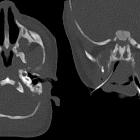Stenose der Apertura piriformis


Pyriform aperture stenosis refers to narrowing of the pyriform aperture and results from early fusion and hypertrophy of the medial nasal processes.
Epidemiology
Pyriform aperture stenosis is a rare cause of airway obstruction, and its prevalence is unknown.
Pathology
Associations
- alobar and semilobar forms of holoprosencephaly
- facial hemangiomas
- clinodactyly
- pituitary dysfunction
- central megaincisor (in 75% of cases)
Radiographic features
CT
HRCT is the imaging modality of choice. It is performed in planes angled along the hard palate with a section thickness of 1-1.5 mm and should include the maxillary spines.
Imaging features of pyriform aperture stenosis include:
- inward bowing and thickening of nasal processes of maxilla
- narrowing of the pyriform aperture measuring less than 8 mm (normal is not <11 mm)
MRI / ultrasonography
Associated intracranial anomalies can be excluded in infants with MR imaging or ultrasonography.
Treatment and prognosis
Treatment of mild cases of pyriform aperture stenosis includes administration of decongestants, which allows time for normal nasal growth. Severe cases may require surgical reconstruction with stent placement, sublabial resection of the anteromedial maxilla, or reconstruction of the anterior nasal passages.
Differential diagnosis
Possible consideration on axial CT images include
- choanal atresia
- choanal stenosis
Siehe auch:
und weiter:

 Assoziationen und Differentialdiagnosen zu Stenose der Apertura piriformis:
Assoziationen und Differentialdiagnosen zu Stenose der Apertura piriformis:



